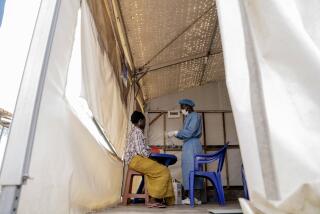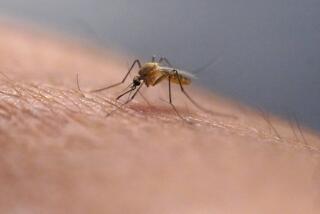Last U.S. Smallpox Outbreak Left Mental Scars on Witnesses
ELSA, Texas — Billie Raney was 21 when she stood on the sidewalk with her three grown sisters, watching morticians drag their mother out of the family home, still wrapped in the sheets in which she had succumbed to smallpox.
Lillian Barber, then 43, was the only person to die in the last smallpox outbreak in the United States, which infected eight known victims in the Rio Grande Valley in 1949.
The survivors are now retired pastors, tractor salesmen, grandmothers and grandfathers. For decades, their names were shrouded in aliases appearing in medical literature.
“I wish it was someone else’s memory,” said Billie Raney, 73. “But at least we’re willing to talk about it and make people aware.”
Since Sept. 11, the disease that was declared eradicated has emerged as a potential terrorism weapon.
According to the Centers for Disease Control and Prevention in Atlanta, a single case of smallpox anywhere in the world would be considered a global health threat.
When the routine vaccinations ceased in 1972, some members of the Barber family questioned doctors and school officials.
“We believed that smallpox vaccinations never should have been stopped,” Billie Raney said. “None of the grandchildren even received it. Of course, we knew the severity of the disease.”
Her father, Virgil Barber, who died in 1978, had always said smallpox came to the family from a bus ride he took to visit his hospitalized wife in February 1949. There was a sick man on the bus, he would say.
Health officials were never quite sure. They concluded that the hospital was where Lillian Barber, who needed a hysterectomy, contracted the disease. It could have come from her visiting husband or an infected oil-field worker who was admitted about the same time.
The first doctor to come to Virgil Barber’s bed in February 1949 suspected he had typhus fever. Days later, when Barber was out of his head with fever and his wife lay ill, one of the boys summoned a second doctor.
“He stopped at the door,” remembered Charles Barber, 69, at the time the oldest of the four boys still living at home. “He sniffed and said, ‘There’s smallpox in here.’ ”
The doctor had been through a smallpox epidemic in Michigan. Though likely immune from his experience up north, he notified the county health department and returned to the Barber home wearing a raincoat for protection.
Nine days later, the doctor who made the initial visit also fell ill. Besides Virgil and Lillian Barber and son Bobby, the doctor, the oil-field worker, a county commissioner and two others are known to have contracted the disease.
Lillian Barber died March 12.
Quarantined, the boys were left alone in the home for eight weeks, finding food at the edge of their property each morning. They would go out in the backyard and boil clothing and sheets clean. The older sisters, who had since moved from the house, arranged for a telephone line for the boys.
Charles Barber was busy tending to his father and his 12-year-old brother, Bobby, as well as two other brothers who did not get sick.
He remembered his father covered head to toe with the deep, purple-black sores.
“I had to put socks on his hands so that he wouldn’t scratch himself. And I would change his sheets, and each time I would burn a double handful of scabs that came off his body. . . . My brother was very sick, but he didn’t break out, not in one solid scab like my daddy.”
Within a few days after the public was notified of the outbreak, local health officials ran through 50,000 pints of vaccine.
More to Read
Sign up for Essential California
The most important California stories and recommendations in your inbox every morning.
You may occasionally receive promotional content from the Los Angeles Times.










